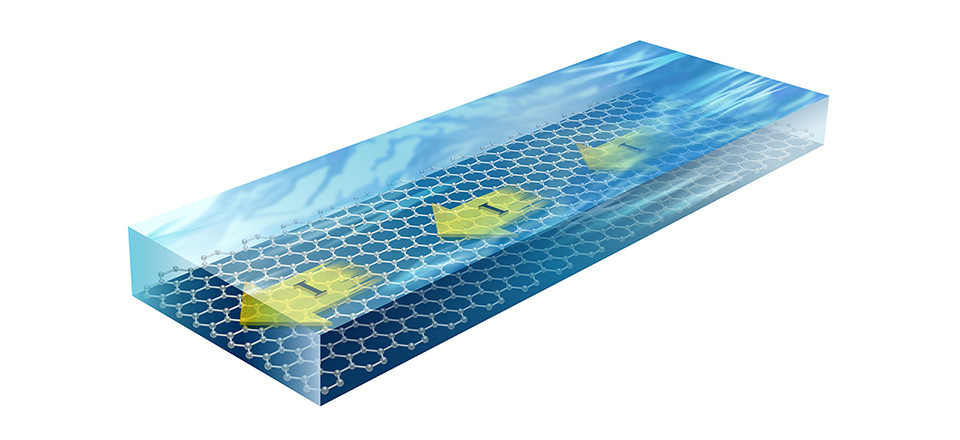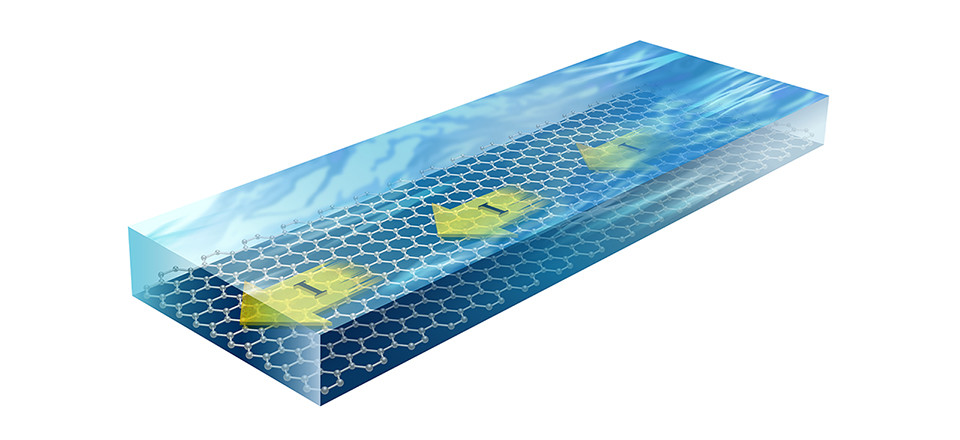• Physics 16, 26
Vibrations are the main drivers of a mysterious process in which a liquid flow generates an electric current in the solid below it.
Liquid flowing over a conducting surface is known to produce electric currents, but the mechanism behind this effect has been unclear. New experiments with a single liquid drop dragged over a graphene surface demonstrate that viscous forces at the liquid–solid interface create vibrations, or phonons, in the graphene sheet that drag electrons in the direction of the flow [1]. The researchers verified this “phonon wind” interpretation by observing multiple liquids and by testing graphene surfaces with and without wrinkles. The results could lead to highly sensitive flow sensors or to devices that can harvest electricity from flows.
Researchers have found that water flowing over a material—in particular, carbon nanotubes or graphene—can generate electric currents in the solid. The effect appears in carbon materials because the surfaces are atomically flat and thus allow the liquid to flow largely unobstructed at the liquid–solid boundary, explains Alessandro Siria from the École Normale Supérieure in France. Several models have been proposed to explain the flow-induced currents, often involving charges within the liquid acting on the electrons in the solid. However, experimental uncertainties have prevented researchers from determining which model is best.
To help resolve the issue, Siria and his colleagues designed an experiment in which a single drop of fluid is dragged across a graphene surface. “Using a single nanodrop allows us to work with an ideal model configuration in which every parameter is known and the experimental results can be better compared to theory,” Siria says. The team’s setup consisted of a small pipette glued to the tuning-fork-shaped probe of a vibration-sensitive microscope. With a drop held at the pipette’s downward-facing tip, the team lowered the probe toward the graphene and used the fork’s vibrations to determine when the drop made contact with the surface.
The team then simulated a flow motion by moving the drop back and forth horizontally. Electrodes recorded an electric current in the graphene of around 10 nanoamperes as the drop moved in one direction and a negative current when it moved in the opposite direction. The amount of current generated did not change appreciably when the team switched from an ionic liquid—one containing charged molecules—to a neutral liquid. This result implies that charge interactions between the liquid and the solid do not play a significant role in the flow-induced currents.
In another test, the researchers discovered that more current was measured in graphene samples with wrinkles than in samples without wrinkles. To explain this behavior, the team developed a microscopic model that included the effect of liquid molecules colliding with the solid surface and generating phonons that move in the direction of the flow [2]. These phonons transfer some of their momentum to electrons in the graphene, like a wind blowing on a cloud of dust. This phonon-wind mechanism had been proposed a decade ago, but the new model describes the way in which wrinkles amplify the liquid-solid collisions that excite phonons in the graphene.
The findings could help in developing applications that rely on flow-induced currents. For example, several research teams are working on energy-harvesting devices that could convert liquid flows—such as rain drops rolling down a roof surface—into electric currents. Others are designing carbon-based sensors that could measure tiny flows within microfluidic chips. These technologies might be improved by modifying the carbon surfaces in a way that enhances the production of phonons, Siria says.
“The paper is very rich and instructive in many aspects that have never been addressed so far at a nanoscopic level,” says condensed-matter theorist Erio Tosatti from the International School for Advanced Studies (SISSA) in Italy. Ming Ma, a nanomechanics researcher from Tsinghua University in China, says he was surprised to see that phonon interactions play a dominant role in flow-induced currents. “The mechanism proposed by this paper can contribute to the control of nanoscale flow and can further be applied in the design of nanofluidic circuits or electrokinetic-based power-generation devices,” Ma says.
–Michael Schirber
Michael Schirber is a Corresponding Editor for Physics Magazine based in Lyon, France.
References
- M. Lizée et al., “Strong electronic winds blowing under liquid flows on carbon surfaces,” Phys. Rev. X 13, 011020 (2023).
- B. Coquinot et al., “Quantum feedback at the solid-liquid interface: Flow-induced electronic current and its negative contribution to friction,” Phys. Rev. X 13, 011019 (2023).
Subject Areas
"flow" - Google News
February 17, 2023 at 11:05PM
https://ift.tt/0TrZnxV
Secret of Flow-Induced Electric Currents Revealed - Physics
"flow" - Google News
https://ift.tt/g3L41FD
https://ift.tt/ROguGZ2
Bagikan Berita Ini

















0 Response to "Secret of Flow-Induced Electric Currents Revealed - Physics"
Post a Comment